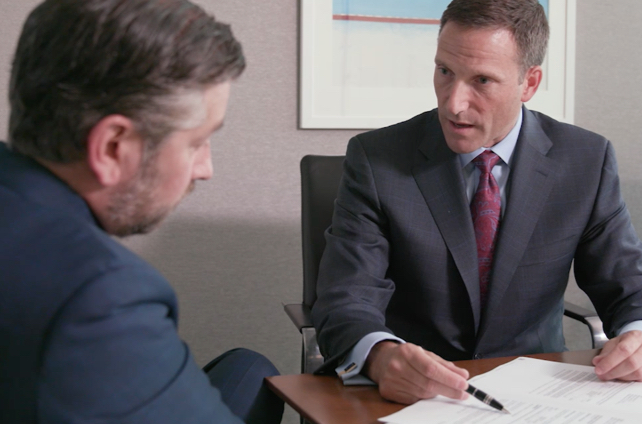Families, Protected.

Real examples of risk*
Out-of-date valuations can cause problems when a will is activated. While completing a property appraisal for estate planning, one client found that a Mark Rothko work had significantly increased in value since the time it was acquired. and was now worth more than $5,000,000. The client's art collection had previously been insured under a blanket policy with a $50,000 per item limit. Had the painting been lost or damaged when it was underinsured, the heirs would have taken a striking loss on the value of the estate.
A comprehensive policy provides coverage for injuries beyond physical harm. Libel is a real threat. A jury in Florida awarded $11.3 million to a plaintiff who accused the defendant of posting defamatory statements about her online. Without insurance broad enough to cover libel and defamation exposures, a client can be left vulnerable.
Homeowner coverage that covers replacement cost in the event of a catastrophic loss is a necessary, and overlooked, protection. One customer with a standard carrier had a home that was insured for $700,000 that suffered a total loss. The cost of rebuilding with the client's high-end finishes and features was $1,000,000—a $300,000 gap. The client was left deciding whether to pay the gap out of pocket or give up features and amenities. With uncapped replacement cost coverage, the full cost of rebuilding shifts to the insurance carrier.
Policy limits need to have an ample ceiling. When a driver stuck a pedestrian at the crosswalk, the impact led to traumatic brain injury and leg damage that led to an above-the-knee amputation. The pedestrian was awarded $26.2 million in damages. Common personal liability coverage is $300,000, a limit that would leave a policyholder with a dramatic gap. An excess liability policy covers far higher limits, and policies with limits of $50 million or $100 million go even farther. Added layers of coverage protect policyholders from large jury awards.

In their own words: the value of working with experts
This P&C agent and trust and estate attorney consistently work with the same clients. Watch their story to see how and why.
Understand risk
Get a quick understanding of important key facts to help you and your clients put property and casualty risk into real-world perspective.
Sources: * Chubb Survey, 2011
• ** Ace Private Risk Services (2012)
• † Marshall & Swift/Boeckh (2013)
• †† Swiss RE (2015)
• ‡ Cyberbullying Research Center (2016)
• ‡‡ Insurance Information Institute (2012)
Frequently not asked questions
Your client's home may be insured for loss based on the market value of the home, but is that the actual cost to replace the home if they need to rebuild? What if the home's market value is less than the rebuild costs? It happens. Also, there are a few insurers who offer replacement cost without a cap.
Valuation goes hand-in-hand with replacement cost coverage because the insurer won't offer replacement cost unless the home is insured to value. Look for an insurer that conducts a complete, interior or exterior appraisal of a home, instead of using a formula. This delivers the best, most precise extimate of replacement cost. Since most companies have capped replacement cost, if the formula has too low a number this means out-of-pocket costs.
Replacement cost is the full cost to replace a covered item at today's prices and without depreciation. An actual cash value settlement basis means that the insurer calculates depreciation and reimburses the policyholder only for the depreciated value of the items. So if the policyholder's home has a power surge and their 100" projection television is fried, they could be paid out the full cost to replace the TV—or could be given the amount that the TV would fo for on the market. Many companies will pay actual cash value, but only after the personal property is replaced or repaired—which means the upfront costs are out-of-pocket for your clients.
Additional living expenses, or as it's called in the industry, Loss of Use, comes into play when a home incurs a covered loss that makes the home inhabitable while it is being repaired. The coverage provides lodging, meals, and reimbursement for any other applicable daily living expenses beyond what the client pays normally. Additional living expenses can add up quickly, particularly in a situation where a home is being rebuilt after a significant covered loss. Look for coverage that allows policyholders to stay comfortable and maintain their standard of living such as in a comparable home in the same school district.
Another big-ticket item is a coverage called rebuilding to code, or Law and Ordinance coverage, which pays for the cost of complying with new or changing building codes following a covered loss. For example: When rebuilding a 75-year-old home that suffered substantial loss due to a fire, contractors find that the cost of rebuilding the home to code will be an additional $100,000. Look to see if the law and ordinance coverage limit is adequate. If the law and ordinance coverage limit is adequate in the insurance policy, that cost would be covered.
When a home incurs a loss from wind, fire, or another peril, there can be a significant amount of debris that needs to be removed, and it can cost thousands and thousands of collars to clean up a property after a significant loss. Debris removal is a coverage your clients should have on their policy, and they should know how much they have.
Additional living expenses, or as it's called in the industry, Loss of Use, comes into play when a home incurs a covered loss that makes the home inhabitable while it is being repaired. The coverage provides lodging, meals, and reimbursement for any other applicable daily living expenses beyond what the client pays normally. Additional living expenses can add up quickly, particularly in a situation where a home is being rebuilt after a significant covered loss. Look for coverage that allows policyholders to stay comfortable and maintain their standard of living such as in a comparable home in the same school district.
Another big-ticket item is a coverage called rebuilding to code, or Law and Ordinance coverage, which pays for the cost of complying with new or changing building codes following a covered loss. For example: When rebuilding a 75-year-old home that suffered substantial loss due to a fire, contractors find that the cost of rebuilding the home to code will be an additional $100,000. Look to see if the law and ordinance coverage limit is adequate. If the law and ordinance coverage limit is adequate in the insurance policy, that cost would be covered.
When a home incurs a loss from wind, fire, or another peril, there can be a significant amount of debris that needs to be removed, and it can cost thousands and thousands of collars to clean up a property after a significant loss. Debris removal is a coverage your clients should have on their policy, and they should know how much they have.
There are three settlement basis options in the automobile insurance market: stated amount, actual cost value (ACV), and agreed value. Stated amount lets the insurance company pay the lesser of two amounts, the stated amount on the policy or the ACV. An ACV settlement basis pays the depreciated value of the vehicle, applying the deductible, leaving policyohlders with a shortfall. The best option is a settlement basis Chubb called agreed value, offered by only a few insurers. It states the value of the automobile on the insurance policy and at the time of the covered total loss, the insured receives the amount on the policy—no deductions for depreciations, no deductible applied.
There are three settlement basis options in the automobile insurance market: stated amount, actual cost value (ACV), and agreed value. Stated amount lets the insurance company pay the lesser of two amounts, the stated amount on the policy or the ACV. An ACV settlement basis pays the depreciated value of the vehicle, applying the deductible, leaving policyohlders with a shortfall. The best option is a settlement basis Chubb called agreed value, offered by only a few insurers. It states the value of the automobile on the insurance policy and at the time of the covered total loss, the insured receives the amount on the policy—no deductions for depreciations, no deductible applied.
This is an individual decision based on a combination of factors. Essentially, the question is, "How much does the individual have to lose?" If a client is involved in a lawsuit, her or his entire net worth and even future earnings can be targeted. Specific considerations include:
- Value of physical assets, including residences, collections of jewelry or art, personal property, etc.
- Investable assets that an individual posesses
- The individual's future earnings
- Inheritances and family money
- Legal environment—does the individual live in a state or county where jury awards tend to be higher than average?
- Whether the individual has an occupation or lifestyle that increases liability risk
A combination of these factors will help clients arrive at the right liability coverage for their situation.
Meet our experts
Please reach out to one of our experts if you would like to learn more about our capabilities or if you would simply like to ask them a question related to their area of expertise.
Aaron Hertsgaard, AVP
Strategic Partnerships Manager for NY & Northeast Regions
ahertsgaard@chubb.com
Laura Doyle, Vice President
Art, Jewelry & Valuable Collections Manager
lmdoyle@chubb.com
Kate Norris, Vice President
Family Office Practice Leader
kathryn.norris@chubb.com









